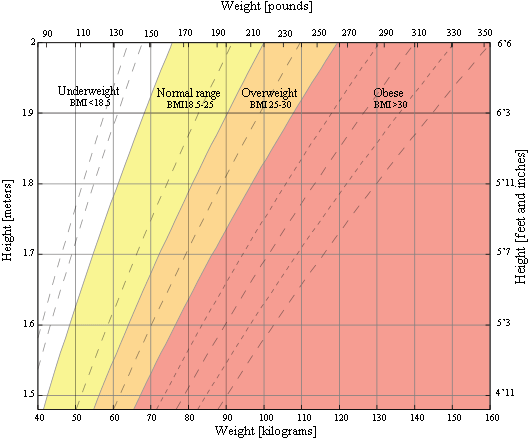BMI Calculator: Easily Check Your Body Mass Index Online
BMI Calculator Easily Check Your Body Mass Index
BMI Calculator
Modify the values and click the calculate button to use
| Classification | BMI range - kg/m2 |
| Severe Thinness | < 16 |
| Moderate Thinness | 16 - 17 |
| Mild Thinness | 17 - 18.5 |
| Normal | 18.5 - 25 |
| Overweight | 25 - 30 |
| Obese Class I | 30 - 35 |
| Obese Class II | 35 - 40 |
| Obese Class III | > 40 |
BMI chart for adults
This is a graph of BMI categories based on the World Health Organization data. The dashed lines represent subdivisions within a major categorization.

BMI table for children and teens, age 2-20
The Centers for Disease Control and Prevention (CDC) recommends BMI categorization for children and teens between age 2 and 20.
| Category | Percentile Range |
| Underweight | <5% |
| Healthy weight | 5% - 85% |
| At risk of overweight | 85% - 95% |
| Overweight | >95% |
Health Risks of Being Overweight
Carrying excess weight significantly increases the likelihood of developing a range of serious health conditions. According to the Centers for Disease Control and Prevention (CDC), the risks associated with being overweight include:
- High blood pressure (hypertension)
- Unhealthy cholesterol levels: Elevated LDL ("bad" cholesterol), reduced HDL ("good" cholesterol), and high triglycerides
- Type 2 diabetes
- Coronary heart disease
- Stroke
- Gallbladder disease
- Osteoarthritis: Joint damage caused by cartilage breakdown
- Sleep apnea and other breathing problems
- Certain cancers: Including endometrial, breast, colon, kidney, gallbladder, and liver cancers
- Reduced quality of life
- Mental health issues: Such as depression and anxiety
- Chronic pain and limited physical function
- Increased risk of premature death compared to individuals with a healthy BMI
As this list shows, being overweight can lead to a variety of negative—and sometimes life-threatening—health outcomes. Generally, maintaining a BMI below 25 kg/m² is recommended, but it’s always best to consult a healthcare professional for personalized advice.
Health Risks of Being Underweight
Being underweight also comes with its own set of health risks, including:
- Malnutrition, vitamin deficiencies, and anemia (reduced ability of the blood to carry oxygen)
- Osteoporosis: Weakened bones that are more prone to fractures
- Weakened immune system
- Growth and development issues (especially in children and teens)
- Reproductive problems in women: Hormonal imbalances can disrupt menstrual cycles and increase the risk of miscarriage in early pregnancy
- Higher risk of complications during surgery
- Increased risk of premature death compared to those with a healthy BMI
Sometimes, being underweight can signal an underlying health issue, such as an eating disorder like anorexia nervosa. If you or someone you know is underweight without an obvious cause, it’s important to seek medical advice.
Limitations of BMI
While BMI is a widely used tool for assessing healthy body weight, it has several limitations:
- BMI does not distinguish between body fat and muscle mass. For example, athletes or bodybuilders may have a high BMI due to increased muscle, not excess fat.
- Body composition varies by age, sex, and ethnicity. Older adults and women typically have more body fat than younger adults and men with the same BMI.
- Activity level matters. A sedentary person with a "normal" BMI may still have unhealthy levels of body fat.
- Children and adolescents: Growth, development, and puberty can affect BMI, making it less reliable for assessing body fat in young people.
Despite these limitations, BMI is still a useful screening tool for most people and can be combined with other measurements for a more complete picture of health.



